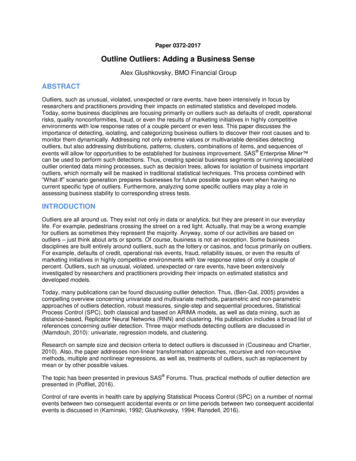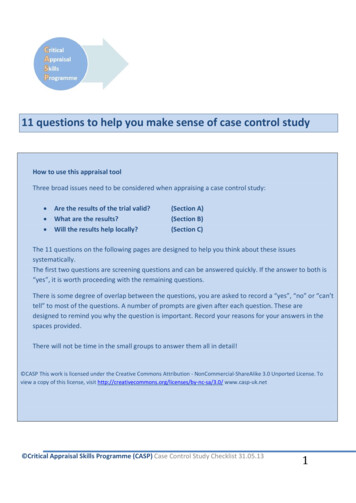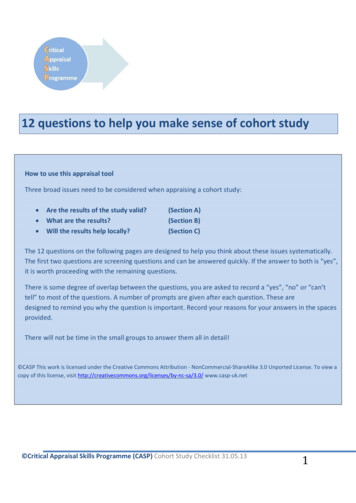
Transcription
Making Sense of MedicareA guide to getting complete health care coverage1
MedicaremadeeasierThis guide is not intended to replace information available to all Medicare recipients in the Medicare & Youhandbook. Please review this and all information available at medicare.gov, which will provide you withcomplete details about Medicare plans, including beneficiary rights, coordination of care, preventiveservices, how to change plans, state assistance options, definitions and more.2
Medicare is something you’ve earned, a benefit you count on. Understanding how it works, how tonavigate and make the most of it, however, is no easy task — especially if you try it on your own.Trusted, impartial guidance from Aon can help you make sense of Original Medicare — and individualMedicare plans that can help complete your coverage needs. Whether you rely on our secure website,or prefer speaking with one of our Licensed Advisors, we’ll help you understand your options so youcan make the right decision for your health.Aon provides: Access to national and regional insurance companies with individualMedicare plans in your area. Clear, current and complete information about the MedicareAdvantage, Medicare Supplement, Prescription Drug, Dental andVision Plans available to you. Help with evaluating your options, comparing plans that fit yourneeds and budget, and enrolling in coverage. Continued assistance after you enroll and as your needs change. Services at no additional cost to you — you only pay for theplan(s) you enroll in. Licensed Advisors who are not incented to promote any carrier orplan over another. They offer objective and personalized guidanceso you can make informed decisions about your benefits.A look ahead34681012141517183 About AonMedicare overviewUnderstanding MedicareBeyond Original MedicareComparing your Medicare optionsMedicare Supplement PlansPrescription Drug PlansKnowing what’s right for youGetting started onlineHow to enroll
Medicare overviewMedicare is a federal program that offers health insurance to Americans and other eligible individuals.EligibilityTo be covered by Medicare, you must be a U.S. citizen or legal resident who has lived in the U.S. continuouslyfor at least the last five years, including the five years just before applying for Medicare. You must also meetone of these criteria: Age 65 or older Younger than 65 with a qualifying disability Any age with a diagnosis of end-stage renal disease (ESRD) or amyotrophic lateral sclerosis (ALS)EnrollmentOriginal Medicare (Parts A and B) helps pay for hospital stays and doctor visits, but it doesn’t cover everything— nor does it cover prescription drugs.You should be automatically enrolled in Original Medicare if you’re receiving Social Security or RailroadRetirement Board benefits when you become eligible. If you’re not receiving benefits, you need to sign up forMedicare when you become eligible.You must have Medicare Parts A and B before enrolling in supplemental coverage. You can sign up inone of three ways:Visit your localSocial Security officeCall Social Securityat 1-800-772-1213(TTY 1-800-325-0778)Apply onlineat ssa.govIf you worked for a railroad, call your local Railroad Retirement Board office or 1-877-772-5772.While Congress has shifted the full retirement age for Social Security benefits from 65 to 66 (and 67 in thefuture), 65 has remained the eligibility age for Medicare.Keep in mind that it may take up to 60 days to get approved for Medicare Part B, and up to three weeks toreceive your Medicare card in the mail.Many people who are still working sign up for Medicare Part A at 65 but delay signing up for Part B if they’recovered by their employer’s insurance. But you must sign up for Medicare Part B no later than eight monthsafter you leave your job and lose group coverage, or you may have to pay a lifetime penalty and experience agap in coverage.If you miss the Part B initial enrollment period, you must wait to sign up for Part B until the next generalenrollment period (January 1 to March 31), and coverage will begin July 1.4
Other coverage choicesMany Medicare-eligibles choose additionalcoverage by enrolling in one or more individualMedicare plans. Medicare Advantage Plans (Part C)combine Part A and Part B, and ofteninclude prescription drug coverage. Someplans may offer additional benefits likecoverage for routine vision and dental care. Medicare Supplement Plans (Medigap) helppay some of the out-of-pocket costs thataren’t covered under Original Medicare. Medicare Prescription Drug (Part D) Planshelp pay for prescription medications.Understanding Medicare — we’ll help you through itThis guide will help you understand your Medicare options and the enrollment process.Activate your personalAon account online.Use our interactive website toenroll online or a LicensedAdvisor can assist you by phone.Pay special attention todeadlines so you don’thave a lapse in coverage.On page 17, you'll find details about how to prepare for enrollment, information you’ll need to have handy,and how our innovative online recommendation tool can help make your buying experience easier.5
Understanding MedicareOver time, your health care needs and budget may change. That’s why there are options that allow you toselect benefits that support those needs.You can choose Original Medicare Part A for hospital stays and Part B for doctor visits, or you can choose aMedicare Advantage Plan (Part C) from a private insurance company. Medicare Advantage Plans combineMedicare Part A and Part B coverage, and many also include prescription drug coverage. Some plans comewith hearing and vision care benefits as well.Medicare Supplement Plans help pay some of your out-of-pocket costs. Available from private insurancecompanies, these plans pay for some of the expenses not covered by Original Medicare, like deductiblesand copayments.In general, here’s what’s covered under Medicare Parts A and BPart A Inpatient care in hospitals Inpatient care in a skilled nursing facility Hospice care services Home health care servicesIn 2020, you pay: Typically a 0 premiumOr A premium of up to 458 per month,based on your work history Deductible: per 60-day benefit periodPart B Medically necessary — Services or supplies todiagnose or treat a condition that meets acceptedstandards of medical practice Preventive — Health care to identify or stop illnessat an early stage Doctor visits Outpatient hospital care Durable medical equipment and suppliesIn 2020, you pay: Typically, the standard premium amount 144.60 20% coinsurance, after 198 deductibleNote: Social Security will contact you if you have to paymore based on your income.What’s not covered by Medicare Parts A and B Most prescriptions Dentures Long-term care (also called custodial care) Acupuncture Cosmetic surgery Health care services not approved by Medicare Hearing aids and associated exams Most dental care Routine foot care Eye examinations related to prescribing glassesEven if a service or item is covered, you’ll generally still have to pay deductibles, coinsurance orcopayments without any annual limit on those costs.6
There is no out-of-pocket cap forMedicare Parts A and B. That meansyour share of costs is unlimited. So it’sa good idea to plan for out-of-pocketcosts by enrolling in an individualMedicare insurance plan.You can review your coverage andmake changes during the MedicareAnnual Enrollment Period (AEP),which runs October 15 – December 7every year.The Medicare Advantage Plan OpenEnrollment Period (MA OEP) runsJanuary 1 to March 31 and allowsanyone currently enrolled in a MedicareAdvantage Plan on January 1 theopportunity to change plans.Good to knowKeep in mind that you must be enrolled in MedicareParts A and B before you can enroll in an individualMedicare Advantage or Medicare Supplement Plan.7
Beyond Original MedicareAs Medicare has evolved, thefederal government allowedprivate insurance carriers tooffer additional options thatcover a wider range of servicesand help retirees manage theout-of-pocket costs. BecauseMedicare (Parts A and B)doesn’t pay for everything,you may want to consider aMedicare Advantage Plan,or a Medicare SupplementPlan along with a PrescriptionDrug Plan.In this illustration,each of the trianglesrepresent a differentpart of Medicare.Part C shows a fulltriangle because itincludes MedicareParts A, B and, inmany cases, Part D,under one plan withone ID card.MAMedicare Advantage Plans provide medical benefits as goodas those covered by Medicare Parts A and B, but with greaterfinancial protection. Many Medicare Advantage Plans also includeMedicare Prescription Drug coverage.With a Medicare Advantage Plan, sometimes abbreviated as “MA Plan”or called “Part C,” the insurance company that offers the plan determinesthe monthly premium and cost-sharing amounts. If you join a MedicareAdvantage Plan, you still have Original Medicare (Parts A and B), but aprivate insurance company is responsible for coordinating your care andpaying claims. Ongoing changes to Medicare Advantage Plans includeadditional supplemental benefits designed to diagnose, treat, or preventhealth conditions. Benefits may include transportation services, mealdeliveries, or even home and bathroom safety devices.ADPart ABAOriginal MedicareCovers: Inpatient hospital care Skilled nursing facility care Hospice care Home health careDPart BBOriginal MedicareCovers: Medically-necessary services: clinicalresearch, ambulance services, durablemedical equipment, mental healthservices, partial hospitalization, secondopinions before surgery Preventive health care services Doctor visits Outpatient hospital care Durable medical equipment and supplies8
Medicare Supplement Plans(also known as Medigap)are designed to “fill the gaps” of MedicareParts A and B. However, these plans do notcover prescription drugs. While there areseveral different Medicare Supplement Planlevels, they are the same nationwide, exceptin Massachusetts, Minnesota and Wisconsin.Medicare Prescription Drug Planscover much of the costs for prescriptiondrugs and can be useful in situations whereprescription drugs aren’t already covered. Someplans have pharmacy networks that offer discountedprices. Plans may also offer a mail-order pharmacybenefit.DMEDSUPPPARTThese optional plans are highly regulated and havestandardized benefits: Medicare Advantage andMedicare Prescription Drug Plans are regulated bythe federal government; Medicare Supplement Plansare regulated by individual states.You’ll pay a monthly premium for a MedicareSupplement Plan in addition to your monthlyMedicare Part B premium. When you choosea Medicare Supplement Plan, you must enrollin a Prescription Drug Plan. If you delay, youwill pay a penalty.CADPart CPart DCovers:Covers:Medicare Advantage Everything MedicareParts A and B coverMore a about MedicareAdvantage Plans: You’ll usually pay a monthly premium foryour Medicare Advantage Plan, but in mostcases there are no deductibles. You’ll pay a copayment instead ofcoinsurance for most medical services.B These plans have an out-of-pocketmaximum, which protects you by setting ayearly cap on your cost for health services.Prescription Drug If you need prescription drug coverage,check the plan to be sure your medicationsare covered. Prescription drugs Check that your preferred doctors andspecialists participate in the plan’s providernetwork or accept Medicare (depending onwhich plan type you choose). Many plans coverprescription drugs Many plans coverdental and vision Before traveling, check with your providerto understand benefits available to you. You should review your plan details providedby your insurance company since benefits,premiums and terms can change annually.9
Comparing your Medicare optionsTo help you explore which coverage would be better suited to your health care needs and budget,let's take a closer look at your options. Keep in mind these high-level comparisons:MedicareAdvantage Plans Medical benefits similar to thosecovered by Medicare Parts A and B Offer greater financial protection Most include Medicare Part Dprescription drug coverageMedicare Supplement(Medigap) PlansOR Designed to “fill the gaps” of Medicare Parts A and B Do not cover prescription drugs Medicare PrescriptionDrug Plans (Part D) Helps pay for medications10
Types of Medicare Advantage PlansIn general, most Medicare Advantage Plans offer nationwide coverage for emergency room, urgent care andrenal dialysis. Some Medicare Advantage Plans have you select a primary care physician from their network,enabling you to receive coordinated medical services, including specialist and hospital care.Health Maintenance Organization (HMO) Plans: You’re required to seek care from providers in the plan’snetwork and you may need your primary doctor’s referral to see specialists.Preferred Provider Organization (PPO) Plans: Typically you're not required to get a referral to see aspecialist and you can see providers outside the network without having to pay all the costs yourself.Fee-For-Service Plans: You can get care from any Medicare-eligible provider who accepts your plan. Theseplans do not offer coordinated care.Coordinated Care Plans: A network of doctors and hospitals work together to provide your care. Each plancreates its own network. In most cases, you will pay most or all costs if you see a provider outside the network.Point of Service (POS) Plans: This HMO plan allows you to visit doctors and hospitals outsidethe network for some covered services, but your copayment or coinsurance is usually higher.Special Needs Plans (SNPs): For people with a range of special needs, including those with chronicdiseases, nursing home residents and people who are eligible for both Medicare and Medicaid.Private Fee-For-Service (PFFS) Plan: You can see any provider in the U.S. who accepts Medicare. MedicalSavings Account (MSA) plans combine Medicare Advantage Plan coverage with a special savings accountthat offers tax advantages to help pay for covered medical expenses.Important considerations You must enroll in Original MedicareParts A and B and pay any premiums. Enrollment in a Medicare AdvantagePlan is through private insurancecarriers. These plans are not offeredby the federal government. At a minimum, all plans provide thesame benefits as those availableunder Original Medicare. Most include prescription drugcoverage as part of the premium. Many plans also include one or more benefitsyou’d otherwise have to purchase separately,such as dental, vision and/or hearing care,wellness programs, gym memberships anda nurseline. Many plans have an out-of-pocket maximum,which caps your financial liability in a givenplan period. If your out-of-pocket costs exceedthis amount, you pay 0 for additional eligibleservices until a new plan period begins. Most Medicare Advantage Plans are limitedto a defined geographic area.Medicare Cost Plans are a type of Medicare Advantage plan that’s available in some states. These plans areprovided by private insurance companies Medicare has approved. Medicare Cost Plans can vary in their costsand coverage. Talk with a Licensed Advisor to explore options in your area.11
Types of Medicare Supplement PlansThere are a variety of standardized Medicare Supplement Plans to choose from. Each plan provides differentbenefits, so it’s important to compare plans before choosing one. The monthly premium for your plan will vary andmay be based on the coverage offered and which insurance company you choose.2020 CoverageMedicare Part A coinsurance and hospital costs(up to 365 days after Medicare benefits are used up)Medicare Part A deductibleABC*DF*,1GL2MN33 3 3 3 3 3 3 3 3 33 3 3 3 33 3 3 3Skilled nursing facility care coinsuranceK250% 75% 50%350% 75%3 350% 75%3 3Medicare Part A hospice care coinsuranceor copayments3 3 3 3 3 3Medicare Part B coinsurance3 3 3 3 3 350% 75%3 3Blood (first three pints)3 3 3 3 3 350% 75%3 33Medicare Part B deductible3 3Part B excess80% 80% 80% 80%Foreign travel emergencies (up to plan limits)(A check mark3380% 80%indicates areas where the plan pays 100% of the benefit cost.)*Plans C and F are only available to individuals eligible for Medicare prior to January 1, 2020.123Plan F also offers a high-deductible plan. If you choose this option, you must pay forMedicare-covered costs up to the deductible amount of 2,340 (in 2020) before yourMedicare Supplement plan pays anything.Maximum out-of-pocket expenses of 5,880 for Plan K and 2,940 for Plan L apply (in 2020).Plan N pays 100% of the Part B coinsurance, except for a copayment of up to 20 for someoffice visits and up to a 50 copayment for emergency room visits that don’t result in aninpatient admission (in 2020).12
Importantconsiderations To enroll in a Medicare SupplementPlan, you must be enrolled inMedicare Parts A and B. Although most Medicare SupplementPlans cover expenses from anyprovider that accepts Medicare, someprivate insurance companies alsooffer a Medicare Select Plan, whichprovides coverage only within adefined network of providers. Checkthat your hospital is included in thatparticular plan’s network. Most Medicare Supplement Plansdon’t require a copayment orcoinsurance for hospital charges. If you enroll in coverage when you firstbecome eligible at age 65, or if youremployer stops providing a groupretiree health plan, you may not besubject to a health screening orunderwriting by the insurer. Medicare Supplement Plans arestandardized in a different way inMassachusetts, Minnesota andWisconsin. Go online to review theplans available in your area or discussyour options with a Licensed Advisor.Planningfor thefutureWhile considering your plan options, if a Medicare Supplement Plan seems to fit yourneeds, consider future changes affecting Medicare Supplement Plans C and F.Under the Medicare Access and CHIP Reauthorization Act (MACRA), existingMedicare Supplement Plans C and F have been replaced by new plans that do notinclude the Medicare Part B deductible. If you had Medicare Supplement Plans C or F in 2019, you’re grandfathered in. After January 1, 2020, theseplans are not available to NEW Medicare beneficiaries. Medicare Supplement Plans D and G offer mostly the same coverage as the plans they replaced, exceptthey do not cover the Medicare Part B deductible. Switching from Medicare Supplement Plan C or F to plans D or G, or switching to a different insurancecompany, may trigger a review by medical underwriters. This means your medical history may influence yourmonthly premium. Medicare Advantage Plans will not be affected.13
Prescription Drug PlansMedicare Part D coverage helps you pay for prescriptiondrugs and can help you manage your health care budgetby providing predictable drug costs. Since OriginalMedicare doesn’t cover most prescription drugs, you’llwant to enroll during your Initial Enrollment Period (IEP),otherwise you may pay a late enrollment penalty.The federal government sets basic guidelines that allPart D plans must meet. Each plan has a list of drugsthat it covers (known as a formulary). Before choosinga Part D plan, review its formulary to make sure yourdrugs are covered. Plans also have different costs, socheck the annual deductible, premiums, copays andcoinsurance to ensure you have the appropriatecoverage to cover your costs. 0Deductible phase 0 – 435Your cost: 100%Importantconsiderations Medicare Part D Prescription Drugcoverage is not automatic. You must enrollfor coverage to begin. If you have other prescription drug coverage,such as Veterans Affairs (VA) coverage,you may not need additional drug coverage.Discuss any other coverage you have witha Licensed Advisor. Part D charges a late enrollment penalty ifyou don’t sign up when you’re first eligible —unless you qualify for an exception. Thepenalty is a fee set by Medicare that getsadded to your premium, and you pay i
Medicare Advantage Plan (Part C) from a private insurance company. Medicare Advantage Planscombine Medicare Part A and Part B coverage, and many also include prescription drug coverage. Some plans come with hearing and vision care benefits as well. Medicare Supplement Planshelp pay some of y











